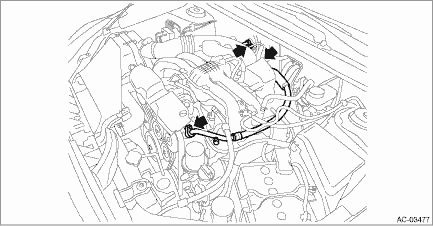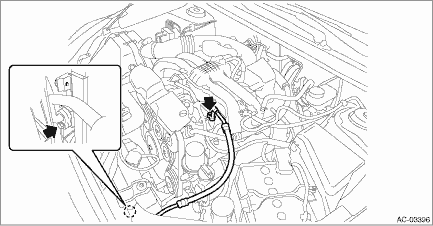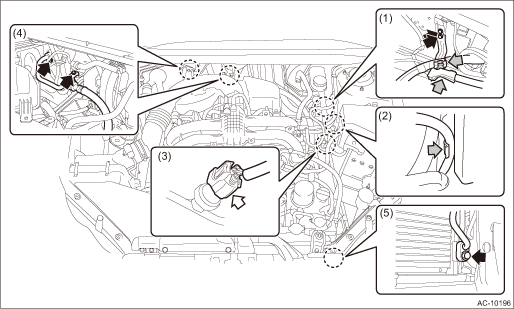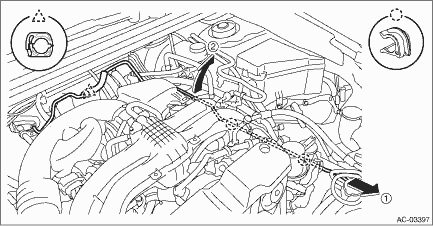Subaru Crosstrek Service Manual: Removal
HVAC SYSTEM (HEATER, VENTILATOR AND A/C) > Hose and Pipe
REMOVAL
1. LOW-PRESSURE HOSE
1. Using the refrigerant recovery system, discharge refrigerant. Refrigerant Recovery Procedure > PROCEDURE">
2. Remove the air intake boot. Air Intake Boot > REMOVAL">
CAUTION:
Move aside the air intake boot to perform the operation without disconnecting the PCV hose.
3. Remove the bolts and remove the hose - pressure suction.
CAUTION:
• Do not apply excessive force to the hose.
• Seal the disconnected hose, compressor and engaging part of expansion valve with a plug or vinyl tape to prevent foreign matter from entering.

2. HIGH-PRESSURE HOSE
1. Using the refrigerant recovery system, discharge refrigerant. Refrigerant Recovery Procedure > PROCEDURE">
2. Remove the reservoir tank. Reservoir Tank > REMOVAL">
3. Remove the bolts, and remove the hose - pressure discharge.
CAUTION:
• Do not apply excessive force to the hose.
• Seal the disconnected hose, compressor and engaging part of compressor with a plug or vinyl tape to prevent foreign matter from entering.

3. A/C PIPE
1. Using the refrigerant recovery system, discharge refrigerant. Refrigerant Recovery Procedure > PROCEDURE">
2. Remove the battery. Battery > REMOVAL">
3. Remove the reservoir tank. Reservoir Tank > REMOVAL">
4. Remove the air intake boot.) Air Intake Boot > REMOVAL">
CAUTION:
Move aside the air intake boot to perform the operation without disconnecting the PCV hose.
5. Remove the pipe - evaporator cooling.
(1) Remove the cable clamps and bolts, and remove the battery cable stay.
(2) Disconnect the battery sensor harness from the main fuse box.
(3) Disconnect the pressure switch connector.
(4) Remove the bolts, and detach the hose - pressure suction from the expansion valve - cooling.
(5) Remove the bolts, and detach the pipe - evaporator cooling from the condenser assembly - air conditioner.

(6) Remove the pipe - evaporator cooling from the clip and expansion valve, and remove the pipe - evaporator cooling in numerical order as shown in the figure.
CAUTION:
• Do not apply excessive force to the pipe.
• Seal the engaging parts of disconnected pipe, hose, expansion valve and condenser with a plug or vinyl tape to prevent foreign matter from entering.
• Do not pull the harness and cable forcibly.

 Inspection
Inspection
HVAC SYSTEM (HEATER, VENTILATOR AND A/C) > Hose and PipeINSPECTION1. Check the hoses for cracks, damage and expansion. Replace the hose if faulty.2. Check the pipes for crack or damage. Replace the ...
 Installation
Installation
HVAC SYSTEM (HEATER, VENTILATOR AND A/C) > Hose and PipeINSTALLATIONCAUTION:• If the hose and pipe have been replaced, add an appropriate amount of compressor oil to the compressor. Compress ...
Other materials:
Installation
LIGHTING SYSTEM > Rear Height SensorINSTALLATION1. Install each part in the reverse order of removal.Tightening torque:Sensor assembly - headlight beam leveler: 7.5 N·m (0.76 kgf-m, 5.5 ft-lb)Rear wheel: Except for C4 model120 N·m (12.24 kgf-m, 88.5 ft-lb)Rear wheel: C4 model100 N&m ...
Disassembly
BRAKE > Front Disc Brake AssemblyDISASSEMBLYCAUTION:Be careful not to allow foreign matter to enter the brake hose connector.1. Remove mud and foreign matter from the caliper body.2. Remove the piston - disc brake.(1) Place a wooden block in the caliper body as shown in the figure to prevent the ...
Specification
VEHICLE DYNAMICS CONTROL (VDC) > ABS Sequence ControlSPECIFICATION1. CONDITIONS FOR COMPLETION OF ABS SEQUENCE CONTROLWhen the following conditions develop, the ABS sequence control stops and ABS operation is returned to the normal control mode.• When the speed of at least one wheel reaches ...
